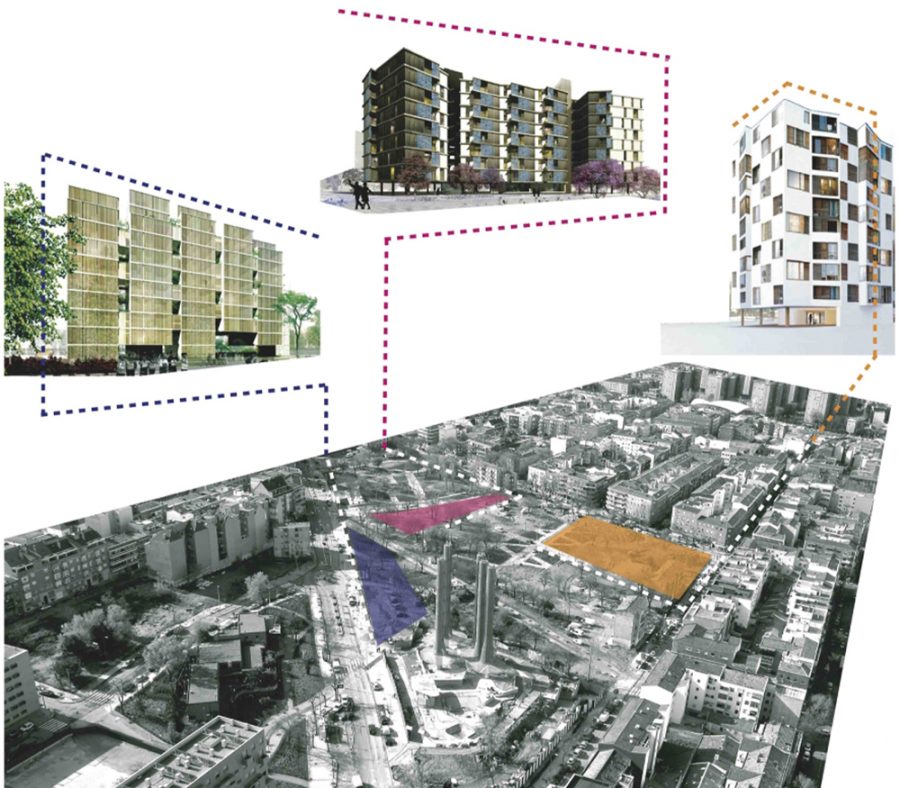Madrid’s brand-new Eco Neighborhood Puente de Vallecas

After almost 30 years of analysis and development, Madrid is set to inaugurate its first neighborhood, designed entirely on environmental and social sustainability criteria. It’s the result of a large and complex process, driven by the Municipal Housing Company of Madrid (EMVS).
A complex Urban Transformation Process
The brand-new Eco Neighborhood Puente de Vallecas occupies the site of two former municipality-owned settlements, which were built in the 50’s to house the huge number of migrants from the countryside. Covering a surface of 8.35 hectares (3,2 square miles), they were characterized by a lack of planning, shortage of infrastructure and bad quality of the buildings with 1083 apartments with only 37 m² (44,2 square yards) of usable area. After a notable degradation of the settlements, the EMVS took them over in 1982 to start the process of regeneration.

The former colonies of Puente de Vallecas, Madrid. Photo courtesy of EMVS
The first phase of work consisted in the analysis of the state of the settlements’ buildings and the creation of a census of its resident population as an imperative step. This was crucial because any transformation process had to include the eviction of the settlements’ dwellers and their resettlement in other buildings close to the neighborhood, process that was finished by 1991.
Hereafter, the modification of the urbanistic parameters for the action area was undertaken by means of a Special Ordination Plan, approved in 2005. Finally, urbanization work was started and at the same time the projects for the residential buildings were selected by architectural competitions.

Implementation of the Eco Neighborhood Puente de Vallecas. Photo courtesy of EMVS
A showcase neighborhood for sustainability
The transformation of the former municipality-owned settlements into the Eco Neighborhood Puente de Vallecas had started: a showcase neighborhood which stands for a new manner to build cities, for a new socially sustainable and environmentally friendly urban development.
The success of this urban regeneration was achieved thanks to social and urbanistic terms and conditions, which turned out to be of fundamental importance:
- Assigning 100% of the built apartments to Protected Social Housing for the most vulnerable sectors of the population.
- Redesign of the urban space by distributing the green spaces, the roads, the residential and institutional buildings following socially and environmentally sustainable criteria.
- Reorganization of roads, vials and foot paths, giving priority to pedestrians and cyclists over the motorized traffic to encourage social exchange among neighbors and among nearby neighborhoods.
- The construction of 20 residential buildings, designed following the rules of bioclimatic architectures to optimize passive energy savings and energy efficiency of the envelope and installations.
- The construction of centralized services for heating and warm water for all new apartments of the neighborhood, offering huge energy savings in general and cost savings for the users. The building for central services also hosts furthermore a neumátaic sistem of absorbtion of urban waste of the whole neighborhood, avoiding unpleasant odours and a negative visual impact of containers in public spaces.

Residential building for social housing by Camacho-Macia Arquitectos. Photo courtesy of EMVS. ©Javier Camacho
Visit the Eco Neighborhood Puente de Vallecas
If you wish to know more about the Eco Neighborhood Puente de Vallecas, and its successful transformation into a modern, high-quality, efficient and sustainable place to live, do not hesitate to contact us. Madrides offers professional guided tours for architects and urban developers in Madrid and its surroundings, we are your local experts for architecture tours and urban development.

Residential building for social housing by Artola Erice Sanchez Arquitectos. Photo courtesy of EMVS
Text by: Werner Durrer, Architect, Madrides






No Comments